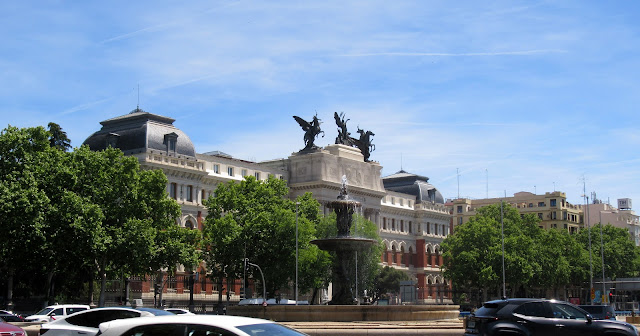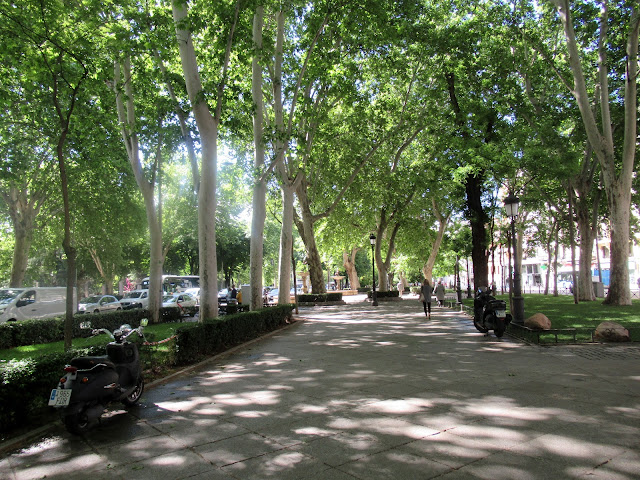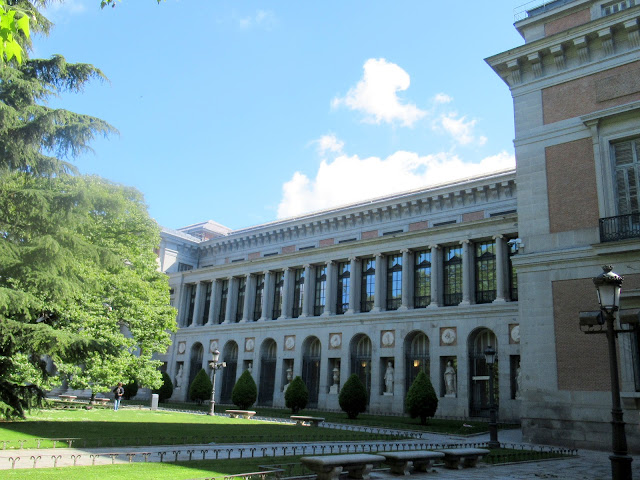Some of Madrid's memorable sights inhabit this barrio, with all of them on or within walking distance of the Paseo del Prado. There are the three world-class museums plus the Parque del Buen Retiro.
The whole area is full of grand buildings but it is the three museums, the so-called Golden Triangle of Art, that are the stars here.
Its collection is mainly dedicated to Spanish art. Highlights include collections of Spain's two greatest 20th century masters, Pablo Picasso and Salvador Dali. The most famous masterpiece in the museum is Picasso's 1937 painting Guernica. Along with its extensive collection, the museum offers a mixture of national and international temporary exhibitions, making it one of the world's largest museums for modern and contemporary art - in 2021 it ranked eigth on the list of most-visited art museums in the world.
The building is on the site of the first general hospital of Madrid. In 1969 it was closed down as a hospital. Extensive modern renovations and additions to the old building were made starting in 1980.
Its architectural identity was radically changed in 1989 by Ian Ritchie with the addition of three glass circulation towers.

I was so pleased to see a Stolperstein as it's so important to acknowledge atrocities wherever they happen and to whoever they happen, and to remember. We saw so many stolpersteine in Berlin, they were everywhere, but particularly in the Spandauer Vorstadt area, which before the war, was the city's Jewish quarter. You can see some of them here
A stoperstein means a stumbling stone, metaphorically a stumbling block, or a stone to stumble upon. They are 10x10cm concrete cubes bearing a brass plate inscribed with the name and life dates of victims of Nazi extermination or persecution. An art project, initiated by the German artist Gunter Demniq in 1992, which is still ongoing, it aims to commemorate individual persons at exactly the last place of residency - or sometimes, work - which was freely chosen by the persons before s/he fell victim to Nazi terror, euthanasia, was deported to a concentration or extermination camp, or escaped persecution by emigrating or suicide. As of 31 January 2017, over 56,000 stopersteine have been laid in 22 European countries, making this the world's largest decentralised memorial. The majority commemorate Jewish victims of the Holocaust, but others have been placed for Sinti and Romani people, homosexuals, Jehovah's Witnesses, black people and other groups that the Nazis exterminated.
It's quite a long walk to the main entrance, since the building is huge. The first time we tried to visit the queues were snaking all around the building - there are queues for everything in Madrid, but this was the longest. So, we went for a second visit to the Reina Sofia on that day, and then booked the Prado online.
The Museo Nacional del Prado, houses collections of European art, dating from the 12th century to the early 20th. Some of the highlights of the collection are the numerous works by Francisco Goya, the single most extensively represented artist, as well as by Hieronymus Bosch, El Greco, Peter Paul Rubens, Titian and Diego Velazquez. Velasquez and his keen eye and sensibility were also responsible for bringing much of the museum's fine collection of Italian masters to Spain, now one of the largest outside of Italy.
It's important, when visiting the Prado, to come armed with a list of the paintings and sculptures you want to see, otherwise you will get lost in the middle of 1300 works that are on display at any one time (out of 8,200 drawings, 7,600 paintings, 4,800 prints and 1,000 sculptures).
There is a large collection of early European painting, with a major collection of 14th and 15th century art; works by leading Renaissance, Baroque and Rococo painters, and a large number of European 19th century art. In other words, a bit of everything. Unlike the other two, the collections are manageable and one is not overwhelmed by the sheer number of what is on show.
The Iglesia de San Jeronimo el Real is in this area as well, behind the Prado. It's quite lovely.
We were intrigued by this gate - Doorway-Passageway in bronze, by Cristina Iglesias (2007)
























No comments:
Post a Comment